-
Paper Information
- Paper Submission
-
Journal Information
- About This Journal
- Editorial Board
- Current Issue
- Archive
- Author Guidelines
- Contact Us
International Journal of Virology and Molecular Biology
p-ISSN: 2163-2219 e-ISSN: 2163-2227
2025; 14(5): 61-67
doi:10.5923/j.ijvmb.20251405.01
Received: May 23, 2025; Accepted: Jun. 20, 2025; Published: Jul. 3, 2025

Investigation of the Impact of Physical Mutagens on the Morphological and Agronomic Traits of Soybean (Glycine max, L. Merr.) Variety Samples
Soatova Feruza B.1, Kurbanbaev Ilkham2
1Alfraganus University, Tashkent, Uzbekistan
2Academy of Sciences of the Republic of Uzbekistan, Institute of Genetics and Experimental Biology of Plants, Laboratory of Genetics, Selection and Seed Production of Legumes, Oilseeds and Medicinal Plants
Copyright © 2025 The Author(s). Published by Scientific & Academic Publishing.
This work is licensed under the Creative Commons Attribution International License (CC BY).
http://creativecommons.org/licenses/by/4.0/

This study presents the scientific research results on the effects of treating soybean seeds from certain varieties in the botanical and genetic collection with gamma (Ƴ) radiation at doses of 50, 100, 200, 300, and 400 Gray before sowing, focusing on their impact on the morphological and economic traits of the soybean. As a result of the research, an analysis was conducted on certain morphological and economic traits in the control plants and the M1 generation plants treated with gamma (Ƴ) radiation at doses of 50, 100, 200, 300, and 400 Gray before sowing. The analyzed traits included plant height, number of nodes per plant, number of pods, and number of fruiting branches. According to the obtained results, it was found that physical mutagens had varying effects on the morphological and economic traits of the studied soybean varieties in the M1 generation plants. In particular, a dose of 50 Gray of gamma (Ƴ) radiation had a positive effect on plant height and the number of nodes per plant; 100 Gray positively influenced the number of nodes and pods per plant; 200 Gray showed a positive impact on plant height and the number of nodes per plant; 300 Gray improved plant height and the number of pods per plant; and 400 Gray also had a positive effect on plant height and the number of pods per plant. In all these cases, better results were recorded compared to the control variants of the experiment. As a result of the research, seeds from the plants that showed positive traits were collected to obtain the M2 generation and set aside for further studies.
Keywords: Soybean, Glycinemax (L.) Merr., Physical mutagens, Ƴ-gamma rays, Morphological characters, Plant height
Cite this paper: Soatova Feruza B., Kurbanbaev Ilkham, Investigation of the Impact of Physical Mutagens on the Morphological and Agronomic Traits of Soybean (Glycine max, L. Merr.) Variety Samples, International Journal of Virology and Molecular Biology, Vol. 14 No. 5, 2025, pp. 61-67. doi: 10.5923/j.ijvmb.20251405.01.
Article Outline
1. Introduction
- Uzbek scientists have also conducted a number of scientific studies on the physiological and biochemical characteristics of soybean and other leguminous crops, as well as on the role of soybean in improving soil fertility [1,2,10]. Soybean seeds are of particular importance due to their content of 28-52% protein enriched with high-quality amino acids, making them comparable to essential food products such as meat, milk, and eggs. Additionally, they contain 18-27% environmentally friendly vegetable oil, various mineral salts, and vitamins. At present, the area under soybean cultivation is steadily increasing [3].The main reason for the widespread cultivation of soybean in many countries is its nutritional value, as both its grain and green mass can be used in food, feed, industrial, and medical sectors. Depending on the variety and growing conditions, soybean seeds contain 30-55% protein and 17-26% oil. Additionally, soybean seeds have 20-25% carbohydrates, over 4-5% minerals (including Ca, P, K, Na, I, Mo, and others), as well as vitamins such as E, B1, B2, and B6 [4,5]. More than a thousand products are derived from soybeans. Soybean is considered one of the main crops in the production of feed protein, oil, meal, and compound feed [6,7]. It is well known that mutation breeding is an effective method for improving valuable agronomic traits in agricultural crops, including enhancing both the quality and quantity of yield. Using this effective approach, Geehan Mohsen (2023) and others conducted studies aimed at increasing the protein and oil content, as well as the yield of soybean. In their research, seeds of the soybean genotypes Giza 21, Giza 22, Giza 82, Giza 83, and 117 were treated with gamma radiation at doses of 50, 100, 200, and 300 Gray before sowing. In subsequent field experiments, these soybean genotypes were evaluated for yield-related morphological traits, as well as characteristics such as seed weight, protein content, and oil content. The results showed that in the M3 mutant lines, gamma irradiation at a dose of 100 Gray had a positive effect on yield traits compared to the parent plants. Gamma irradiation at a dose of 100 Gray was found to have a particularly positive effect on traits such as the number of fruiting branches, pods, and seeds per plant, as well as the protein content in the seeds. Gamma irradiation at a dose of 200 Gray was also reported to have a positive effect on traits such as plant height, number of pods, and oil content [8].An analytical article on induced mutagenesis in soybean was published by Mudasir Hafiz Khan and Sunil Dutt Tyagi (2013). In this article, it is stated that mutations identified through induced mutagenesis in soybean have been extensively covered in various publications. It is emphasized that mutation breeding is more widely applied compared to other breeding methods in agricultural crops and has proven effective in developing new forms with valuable traits. The effectiveness of this method is also characterized by the induction of new mutant forms in different crops, leading to the development of new varieties. The article focuses on providing a comprehensive review of the scientific studies conducted on induced mutagenesis in soybean, based on available literature. In addition, the review article provides detailed information on different mutagens that cause mutations, their positive effects on soybean yield and seed quality, and other mutagens that enhance resistance to various diseases [9].The aim of this study is to investigate the effects of treating seeds of certain soybean varieties from the botanical and genetic collection with gamma (Ƴ) radiation at doses of 50, 100, 200, 300, and 400 Gray before sowing, focusing on their impact on the morphological and agronomic traits of soybean.
2. Materials and Methods
- The experiments were conducted at the Durmon field trial site of the Institute of Genetics and Experimental Plant Biology, Academy of Sciences of Uzbekistan. As research materials, soybean varieties Nafis, Genetik-1, Selecta-302, Sochilmas, Khotira, Gen-8, Gen-9, Gen-25, BK-6, and Kol-17, available at the "Leguminous, Oilseed, and Medicinal Plants Genetics, Breeding, and Seed Production" laboratory, were used. Before sowing, the soybean seed samples were treated with gamma (Ƴ) radiation at doses of 50, 100, 200, 300, and 400 Gray. The treatment of soybean seeds with various doses of gamma radiation before sowing was carried out by expert scientists from the Institute of Nuclear Physics, Academy of Sciences of Uzbekistan. All experiments were repeated three times, and the obtained data were analyzed using the ANOVA STATGRAPHICS statistical software.
3. Results and Discussion
- In the field experiments, for each soybean variety, 20 seeds were sown for both the control and treatment variants (50, 100, 200, 300, and 400 Gray). The germination of M1 plants, whose seeds were treated with different doses of gamma (Ƴ) radiation before sowing, was comparatively studied in both control and treatment variants. In the control variant of the experiment, the germination rate of the plants ranged from 75% to 97%. The highest rate was observed in the Genetik-1 variety at 97%, while the lowest rate was recorded in the Khotira variety at 75%. In the treatment variant where seeds were exposed to a 50 Gray dose before sowing, the number of germinated plants was somewhat lower compared to the control, ranging from 55% to 72%. In the variant treated with a 100 Gray dose of gamma (Ƴ) radiation, the highest germination rate was observed in the Ehtiyoj variety at 58%, while in the Kol-17 sample, this rate was 47% (Fig. 1).
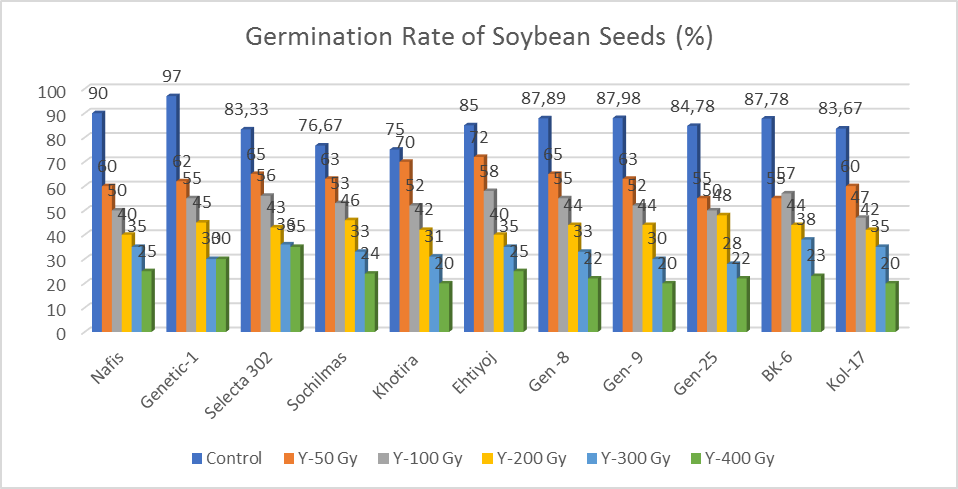 | Figure 1. The effect of gamma (Ƴ) radiation on the germination of different soybean varieties and samples |
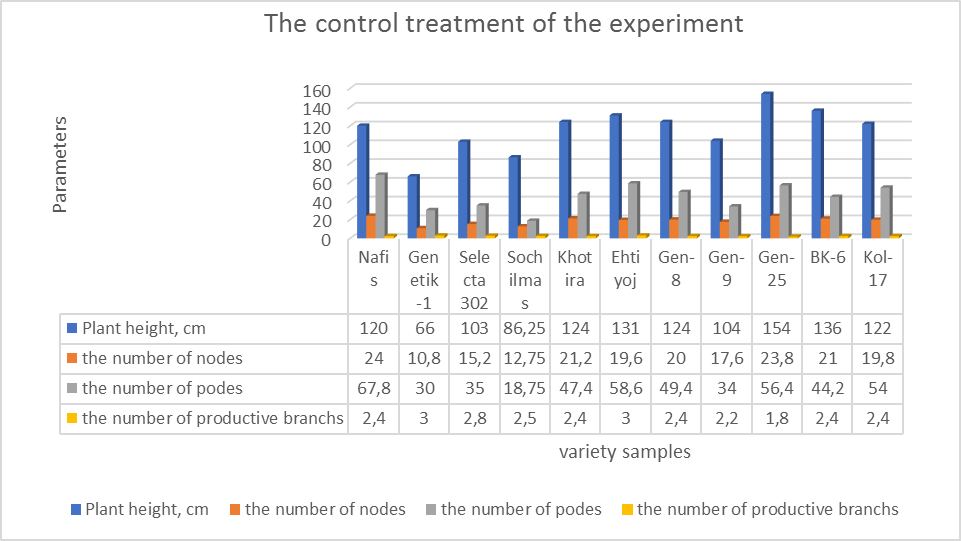 | Figure 2. Indicators of plant height, number of nodes, number of pods, and number of productive branches in the control variant of the experiment |
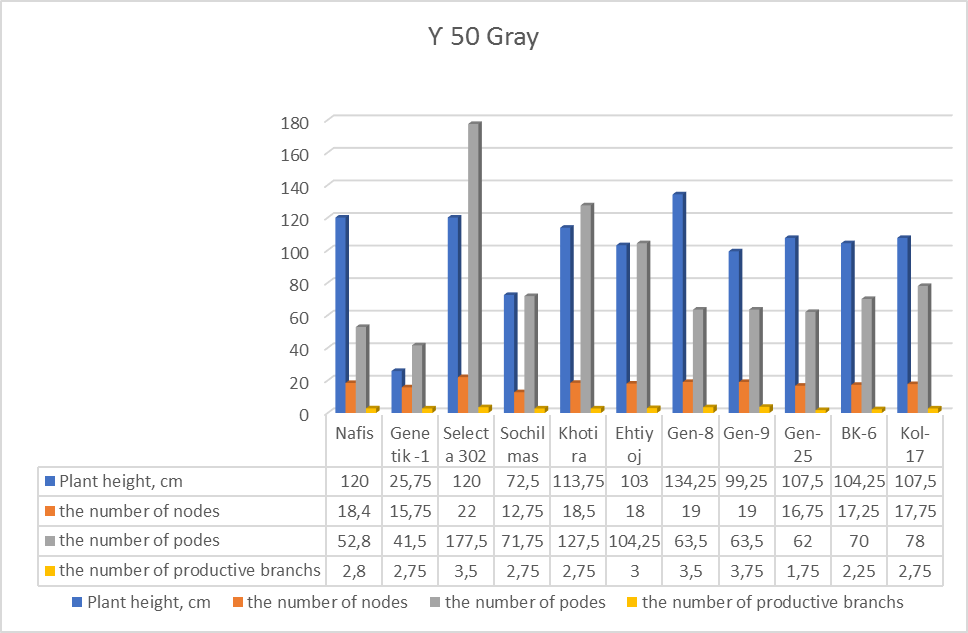 | Figure 3. Indicators of plant height, number of nodes, number of pods, and number of productive branches in the variant treated with a 50 Gray dose of gamma (Ƴ) radiation in the experiment |
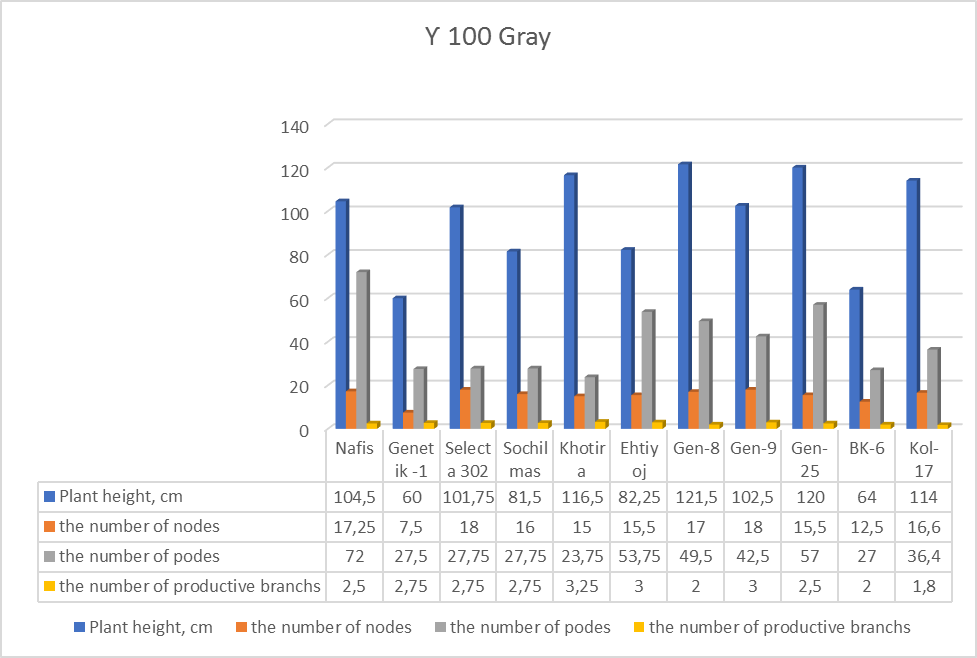 | Figure 4. Indicators of plant height, node number, pod number, and productive branch number in the variant treated with 100 Gray dose of Ƴ-gamma rays |
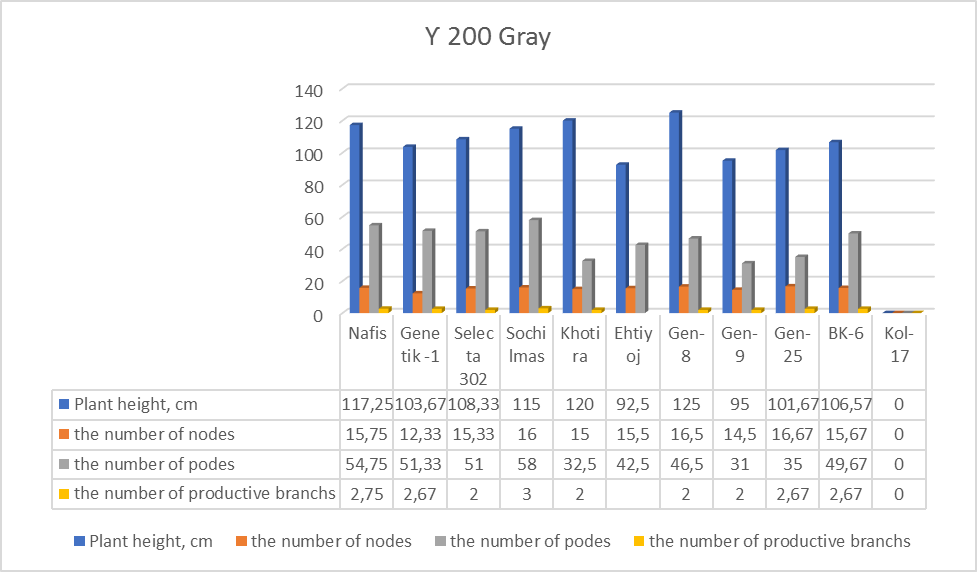 | Figure 5. Indicators of plant height, node number, pod number, and productive branch number in the experimental variant treated with 200 Gray dose of gamma radiation |
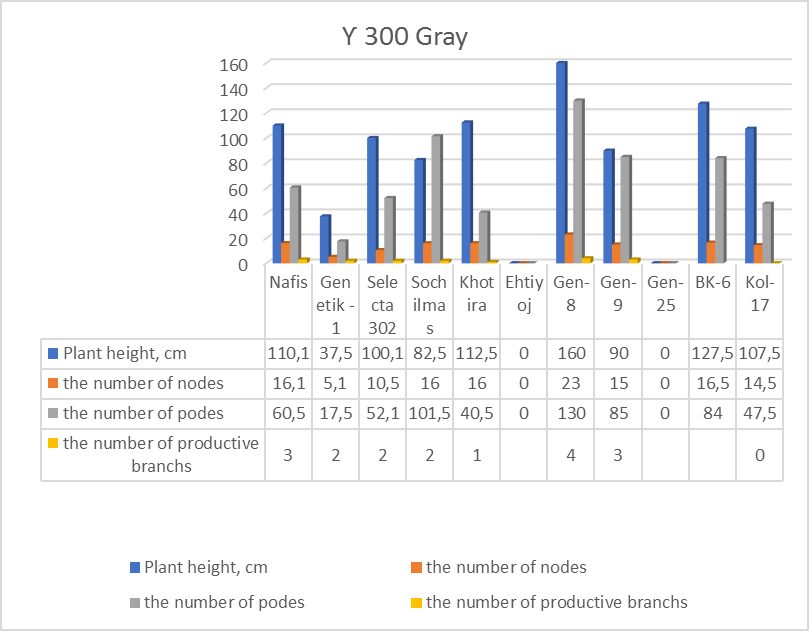 | Figure 6. Indicators of plant height, number of nodes, number of pods, and number of productive branches for the soybean varieties treated with a 300 gray dose of gamma rays |
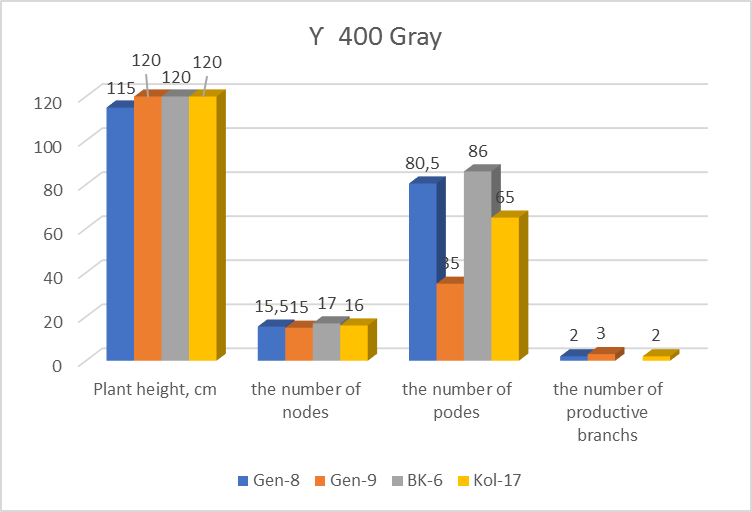 | Figure 7. Indicators of plant height, number of nodes, number of pods, and number of productive branches in the variant treated with a dose of 400 gray of Ƴ-gamma rays in the experiment |
4. Conclusions
- Thus, in the experiment with control and pre-sowing variants treated with Ƴ-gamma rays at doses of 50, 100, 200, 300, and 400 gray, it was observed that as the dose of physical mutagens increased, the productivity decreased. In the studied soybean varieties, a significant decrease in productivity was observed in the variants treated with a 400 gray dose of Ƴ-rays, where productivity decreased by up to 67%. However, even under the influence of the high dose of gamma rays in the M1 plants, the retention of productivity provided the possibility of identifying genotypes for further research as a valuable source. In the experiment, various morphological traits, including plant height, number of nodes, number of pods, and number of yield branches per plant, were analyzed for variants treated with different doses of Ƴ-gamma rays before sowing and in the control group. The results showed that the physical mutagens had varying effects on the morphological characteristics of the studied soybean varieties. Specifically, a 50 gray dose of Ƴ-gamma rays had an impact on plant height and the number of nodes per plant, a 100 gray dose influenced the number of nodes and pods per plant, a 200 gray dose affected plant height and the number of nodes per plant, a 300 gray dose influenced plant height and the number of pods per plant, and a 400 gray dose positively affected plant height and the number of pods per plant. These positive effects were observed in comparison to the control variants of the experiment. Based on the positive indicators, M2 generation seeds were collected from the plants for further research.
ACKNOWLEDGEMENTS
- This article was prepared based on scientific research conducted within the framework of state scientific programs of the Academy of Sciences of the Republic of Uzbekistan, which is funded by the state budget of the Republic of Uzbekistan.
Conflict of Interest
- The authors of this article have no conflicts of interest.
 Abstract
Abstract Reference
Reference Full-Text PDF
Full-Text PDF Full-text HTML
Full-text HTML